Helium Balloon Projects

The Virgin Global Challenge Project was an attempt by the Virgin Group’s Chairman Sir Richard Branson and Balloonist and Entrepreneur Per Lindstrand to circumnavigate the world non-stop by balloon.
During 1995 and 1996 in the capacity of Senior Special Projects Engineer and from 1997 to 1999 in the capacity of Technical Director Virgin Global Challenge, Leon Eversfield held the prime responsibility for structural integrity and safety of the balloon and capsule systems.
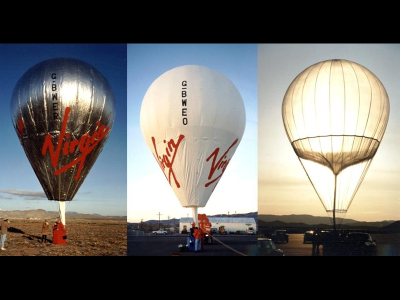
Three of the 400m3 (14,000cuft) experimental helium balloons tested to establish the thermal characteristics of the fabric coatings. The clear envelope was built to compare published scientific high altitude data on multi million cubic foot envelopes with this small envelope to help validate the simulation tools. Aeromechanics analysed the flight test data and used this to scale the flight characteristics to the final 30,000m3 (1,000,000+cuft) global challenger balloons.
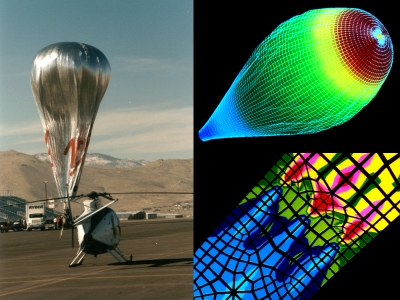
A 2,000m3 (70,000cuft) envelope prepped for flight testing in Reno Nevada. This was a mid sized balloon that was used for scientific modelling to extrapolate data to 30,000m3. The smallest size built were the 400m3 on the pictures above these and the largest was 6,000m3. Three different sizes were used to establish the non-linear characteristics because only a straight line can be drawn between two sizes.
Each balloon design was modelled by Aeromechanics using membrane Finite Elements and non-linear solution techniques due to the large displacements and material non-linearity behaviour. Many structural tests were conducted to validate the Finite Element modelling so that confidence in the integrity of the global balloons at altitudes up to 40,000ft at temperatures as low as -60C were assured. Significant effort was expended in developing fabric properties from biaxial testing to critical tear testing.
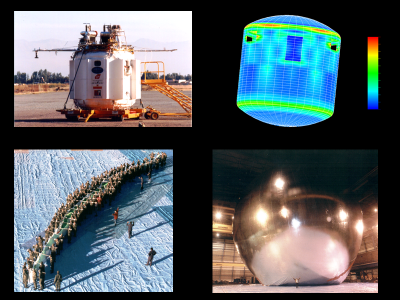
Top left: The Virgin Global Challenger capsule sitting on the low loader system that Aeromechanics instigated so that the capsule could be driven under a stationary envelope rather than attempting to move an envelope over a stationary capsule.
Top right: One of the many structural Finite Element Models constructed by Aeromechanics to design, optimise and promote safety. The man rated capsule has over 40 tonnes of force trying to blow it apart once it is at altitudes of over 8,000ft.
Bottom left: The envelope sling that Aeromechanics devised for manoeuvring the three tonne Global envelope. Powered by 120 personnel all with ultra sensitive feel, this was the preferred method of handling the envelope rather than using cranes and ropes that have no feel if something is amiss.
Bottom right: The all important final quality assurance proof pressure test. With over six miles of thermal welds in each Virgin Global Balloon, we would rather find out the issues on the ground than at 30,000ft!
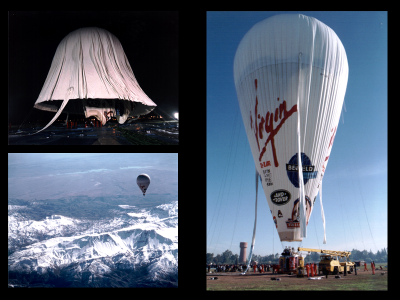
Top left: Peace and tranquillity in the early hours of the morning as the 1,000,000 cuft envelope ascends on its 16 winch, 96 tether cable mooring system that Aeromechanics devised. The reason for the jelly fish like appearance is that like two thin films in contact with each other, the envelope fabric is stuck to itself.
Right: The Global balloon mated to the capsule with its 6 tons of propane fuel almost readied for launch. Note the three multi-functional appendix tubes hanging from the upper section of the envelope. These are accurately designed and built vent tubes that prevent the envelope from over pressurising in the event of a fast ascent as well as providing the means of inflating with helium.
Bottom Left: Within an hour of Launch the Virgin Global Balloon fully pressurised tracks over the Atlas mountains at precisely the launch altitude of 30,000ft.
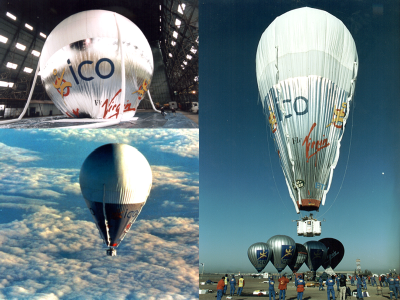
Top left: The last of the five Global Balloons constructed for the second attempt to circumnavigate the globe undergoes its proof pressure test overseen by Aeromechanics at the famous rigid airship hangars in Cardington, Bedfordshire UK. At nearly 1.3 million cuft (36,000m3) and 135ft (41m) high just for the helium cell, such buildings with clearance to spare are few and far between.
Right: Seconds after lift off and the Global balloon climbs slowly against a temperature inversion on its way to the 30,000ft jet stream almost directly above. Soon after the Global balloon had reached a safe altitude and expected trajectory, all key personnel were flown back to the command centre in London to monitor the potential three week flight.
Bottom left: The Global balloon with Richard Branson, Steve Fossett and Per Lindstrand serenely traverse the troposphere at 30 to 35,000ft.
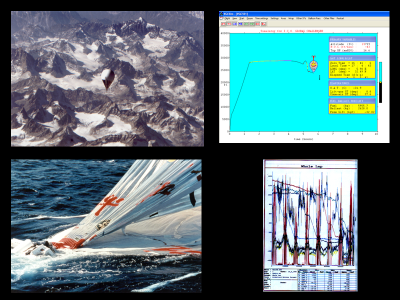
Top left: The Global balloon just clears the peaks of K2 and Everest in the Himalayas trying to thread through a narrow corridor.
Top right: The view in the command centre for practically the whole duration of the flight. Multiple computers were running the flight simulation software. The model had been validated by the flight test programmes on the smaller balloons and the first global balloon flight. With weather data being supplied for the whole of the northern hemisphere the pin-point accuracy of the balloon’s flight trajectory and position was impressive.
Bottom right: A print out of some of the key telemetry data that was relayed from the capsule to the command centre real time over the eight day flight. Such was the data collected that we could tell if a pilot sneezed!
Bottom left: Despite the fact that the system could have completed the whole journey, the Jet Stream winds faded and the decision was made to land near the safety of Hawaii. The toughness of the envelope dragging over 12 tonnes through the pacific at over 20knots was a testament to the build quality.

